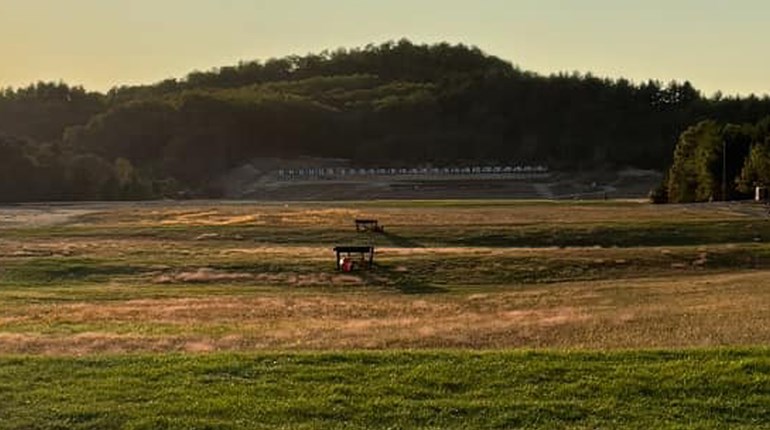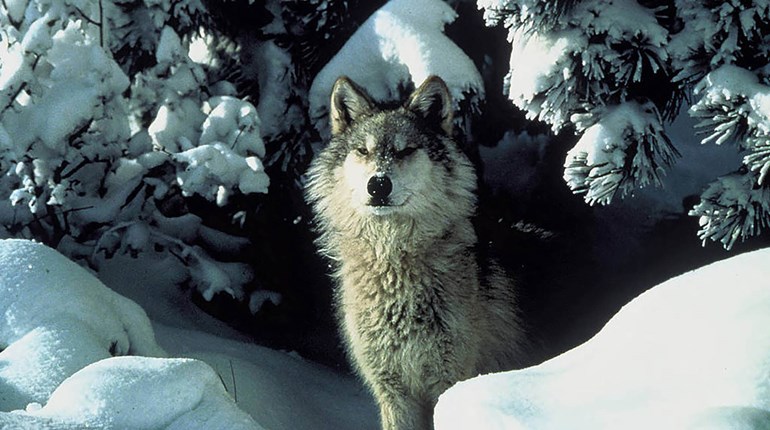With legs cramping, nose freezing and butt dragging, I sighed with gratitude while nestling into a hilltop brush pile left by loggers on a sprawling clear-cut in northern Wisconsin.
Who wouldn't have felt privileged to be there on that cold day in mid-December 2012? Of the 20,272 hunters and trappers applying for a Wisconsin wolf tag that fall, I was among the lucky 6 percent who got drawn for the state's first managed wolf season.
Therefore, quitting wasn't an option while daylight remained. I had slow-hiked the clear-cut's perimeter the previous few hours. When finding a high spot with good views, I attached my rifle's bipod, dropped a seat cushion atop a snow-dusted log or rock, and sat to call and watch for a half-hour or so before moving and trying again.
A logger I met along a two-track road at another logging site had steered me to this site after seeing tracks and hearing wolves here a day earlier. Deer move in when hearing chainsaws, intent on eating cedar fronds and limb tips of fallen aspens and hardwoods. In turn, wolves often show up to hunt browsing deer.
After slogging back to my truck after dusk, I reluctantly drove home while planning a post-Christmas return. That plan died a day later when hunters and trappers surpassed Wisconsin's 116-wolf quota Dec. 23 by one wolf, triggering the season's closure.
Sigh. All I could do was quote Teddy Roosevelt, who called the wolf the "beast of waste and desolation." I felt a bit wasted and desolate myself, conceding my greenhorn status as a wolf hunter and trapper. My lifelong passion for deer hunting hadn't exactly prepared me for wolves. And then, just when I was finally piecing together some plans and strategies based on 11 days afield the previous few weeks, wolf season ended.
That sudden ending confirmed there's nothing easy or casual about this wolf-hunting business. I found far more deer tracks and buck pellets than wolf tracks and Canis lupus poop wherever I hunted and trapped in Ashland, Taylor, Adams and Price counties. If nothing else, those efforts helped me appreciate the success other hunters and trappers enjoyed while filling Wisconsin's 116-wolf quota in 2012, and the 251-wolf quota in 2013.
Time and distance, I found, are two of wolf hunting's biggest challenges for those of us who don't live among wolves. Compared to deer and small game, wolves aren't numerous, widespread, accessible and stationary enough for day-trips and weekend getaways from distant homes—even if the distance is only 100 to 200 miles each way (in my case). Setting traps isn't an option for one-day quickies, which basically leaves you with calling and cruising from scratch each time you show up.
Therefore, it's not surprising to learn that during Montana's 2013 wolf season, only 9 percent of hunters used calls, and 51 of 58 (88 percent) wolves killed during the state's general/archery seasons were taken "opportunistically." That is, they were shot while the permit holder was primarily hunting deer, elk or other game, including three killed by bowhunters.
And in Wisconsin, hunters learned if they wait for cold weather to start calling, they might never leave the house. The quota in most areas will be filled and the season closed because of trapping's effectiveness and popularity. During the state's inaugural wolf season in 2012, 67 percent of the kill occurred between the Oct. 15 opener and before the late-November firearm deer season, with trappers claiming 78 percent of the kill. In 2013, the pre-deer season wolf harvest jumped to 83 percent of the total, with trappers claiming 81 percent of the kill.
In fact, of Wisconsin's six wolf hunting/trapping zones in 2013, five filled their quota two weeks to four weeks before late-November's gun-deer season. And once Wisconsin's unique wolf-hound hunting season opened in the one open zone Dec. 2, all it took was fresh tracking snow at mid-month for houndsmen to kill 35 wolves to fill the remaining quota by Dec. 23.
Wolf Seasons Vary by Region
Trapping, however, hasn't dominated Western wolf seasons. Of 230 wolves taken during Montana's 2013 season, trappers took 87 (38 percent). And of the 302 wolves taken by Idaho sportsmen in 2013, trappers took 104 (34 percent).
Further, while Wisconsin and Minnesota filled their statewide quotas during their 2012 and 2013 wolf seasons, Michigan didn't allow trapping and its hunters took 22 wolves, well short of the 43-wolf quota for its inaugural wolf season in the Upper Peninsula. Even so, Great Lakes sportsmen generally experience more success than Western hunters.
That doesn't surprise David Mech of Minnesota, a world-renown wolf biologist who believes state wildlife agencies have been conservative since regaining wolf-management responsibilities from the U.S. Fish and Wildlife Service (USFWS) in 2011. Unlike critics who thought wolves would be pushovers for hunters and trappers, Mech's 40-plus years of trapping them for research have taught him otherwise.
"They surely aren't easy," said Mech, a senior research scientist with the U.S. Geological Survey's Northern Prairie Wildlife Research Center and adjunct professor at the University of Minnesota-St. Paul. "They cover a lot of ground, they live in big country, and the odds of finding them on any given day aren't great. That's especially true on Western landscapes."
Mech notes that the northern Great Lakes states feature greater wolf densities, smaller wolf packs, more accessible lands, and more hunters and trappers. "You have more wolves to start with in the Great Lakes, especially in Minnesota," he said. "And you have a fair number in Wisconsin; which has more wolves than Wyoming or Montana. Plus, they're more concentrated in Wisconsin. There's lots of places in Wisconsin where you know you shouldn't bother hunting because they aren't there. Whereas in western Montana, wolves could be almost anywhere."
Adrian Wydeven, Wisconsin's former wolf biologist, agreed, noting that at least one road passes through the territory of every wolf pack in the state. "We have some big woods in Wisconsin, but nothing even close to something like the Frank Church (River of No Return) Wilderness in Idaho," Wydeven said. "You have to pack in to hunt many of those Western areas. But you can drive to every one of Wisconsin's wolf packs."
 Learning in the Future?
Learning in the Future?
But no matter where wolves live or where they're hunted, no one expects them to become easier to hunt and trap, even as sportsmen gain experience and hone new skills.
"I've never hunted wolves, but I trapped them more than 20 years, and we rarely caught the same wolf twice," Wydeven said. "And I don't know of any wolf that got caught more than twice. Most Wisconsin wolves have experience with traps because they sometimes stumble into fox and coyote traps when they're pups or yearlings. They can often pull out of those smaller traps. If they live to age 2 or so, they're fairly trap-savvy."
Age and experience was evident in Wisconsin's wolf harvests in 2012 and 2013. Adults made up only a quarter of the kill each year. Meanwhile, pups made up 49 percent of the kill in 2012 and 56 percent in 2013, and yearlings made up 26 percent of the kill in 2012 and 21 percent in 2013.
Mech expects young wolves to continue to dominate the annual harvests, because that's always when animals are most vulnerable. Even so, it's tough to document how quickly or how much wolves change their behavior in response to hunting and trapping pressure.
"Eventually, I'd expect wolves to grow warier and success rates to decline over a period of years," Mech said.
In reflecting on his decades of research, Mech said the only certainty is that wolves are tougher to catch than fishers, martens, lynx or bobcats.
"Whether they're harder to catch than a coyote is controversial," he said. "There's more coyotes around, but some people who trap coyotes and wolves think a smart coyote is harder to catch than a smart wolf. Personally, I don't know that. It's hard to quantify claims like that."
Wydeven said wolves hunker down in less-traveled areas when pressured. "During deer season, we know they often hole up in spruce bogs," he said. "We always had some wolves with radio collars, so we could follow their movements. They knew how to avoid humans. I expect they'll travel more at night, but we also know they'll go where there's deer. We're seeing more wolves around towns when deer congregate near backyard feeders."
Mech said another factor also interests him: Will interest in wolf hunting persist once the novelty wears off? So far, the answer appears no. More than 20,000 hunters and trappers applied for Wisconsin's first 1,160 wolf licenses in 2012. But even with more licenses available in 2013 (2,510) and 2014 (1,500), the number of applications declined to 16,000 in 2013 and 14,500 in 2014.
"A lot of factors go into this," Mech said. "The first year everyone wants to get out there and try it—get their trophy and all that. If they get one, they'll probably get a rug made rather than sell the pelt. But then what? How many people will want two wolves and two rugs? Those kinds of questions we can't answer until we've hunted wolves a few years."
Maintaining Control
One thing state wildlife agencies have proven already, however, is that they can tightly regulate wolf harvests and close seasons quickly to prevent biologically significant overharvests.
Minnesota, for example, overshot its 400-wolf goal by only 3.5 percent (413) in 2012, and its 220-wolf goal by 8 percent (237) in 2013. Wisconsin overshot its 116-wolf goal by one animal in 2012, and then overshot its 251-wolf goal by six animals in 2013 (2.4 percent) in 2013.
Even so, opposition to wolf seasons remains strong among anti-hunting and wolf-advocacy groups. For example:Michigan shelved plans for its second wolf season this year while voters consider two referendums in November about the controversial hunts. Wyoming was trying to get its wolf season reinstated after a federal judge in Washington, D.C., ordered it halted in September.
Idaho Fish and Game officials in July suspended a plan to try boosting elk numbers by hiring a professional hunter to kill wolves in the Frank Church River of No Return Wilderness.
Wisconsin continues to debate a special season in December that allows hunters to use hounds to trail wolves—much as they do bears, bobcats, coyotes and raccoons—provided the harvest quota hasn't been reached.
None of these debates surprises Ed Bangs of Helena, Mont. Bangs spent 23 years as the USFWS wolf-recovery coordinator, a job that still generates damnation from all sides three years after he retired.
Bangs said the Rocky Mountain region's wolf population should have been delisted in 2002, not nearly a decade later in Wyoming, Idaho, Montana, and parts of Utah, Oregon and Washington. When Bangs took the federal wolf job in 1988, the 14 wolves in Montana's Glacier National Park were the Northern Rockies' only wolves. By the time he retired in 2011, the region held nearly 2,000 wolves and state wildlife agencies were more than ready to step in.
"The states are doing a fine job managing wolf populations, but the drama surrounding wolves will never end," Bangs said. "If any animal can hold the hopes and dreams of mankind, it's the wolf—at least in the United States. People in Alaska and Canada get a hoot out of the way Americans yell and holler about wolves. They generate so much emotion and so many value judgments.
"Many people don't look at wolves as animals," Bangs continued. "They really don't even love or hate wolves; they love and hate what they think wolves are. Wolves and wolf management have almost nothing to do with reality. The science is easy. It provides all the facts we know about wolves. But people interpret facts through different lenses, and turn wolves into symbols as if they're a national flag or the hometown team."
Bangs said it's a shame wolves are so controversial because the debates obscure a great wildlife-management success story. "From Day 1, the goal of the U.S. Fish and Wildlife Service was to recover the wolf population and turn the program over to the states and native tribes, and that included opportunities for public hunting and trapping," he said. "We met the goal's requirements more than a decade ago. Wolves aren't this fragile population that states can't handle. They're not going to wipe out the wolf. Even if you make a mistake and take a few more than you planned, you can get that back very easily. We've proven that well."
Conclusion
Still, Bangs is optimistic that hunting and trapping seasons will eventually reduce the political storms surrounding wolves.
"When you look at public-opinion surveys on wolves, animosity against wolves starts dropping once people can hunt them," he said. "Meanwhile, four or five years later, people start seeing there's about as many wolves as when the seasons began. Sure, the debates will go on and on, the emotions will remain for the hardened on both sides, and groups will keep using wolves to raise money for their causes. But a number of people will lose interest, and the arguing and debating will decline. This is just part of the human drama."
Meanwhile, some of us will keep applying for wolf tags each year, confident that wildlife managers will maintain a healthy wolf population that provides opportunity and an annual harvest for hunters and trappers.






































